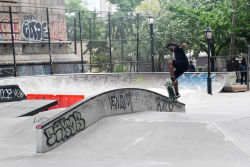Coleman Playground
Coleman Square Playground
Bounded by Cherry, Pike, and Monroe Streets, Coleman Square Playground lies on the border between Chinatown and the Lower East Side. It is named in honor of U.S. Army Corporal Joseph Francis Coleman (d. 1919), son of Thomas Coleman and Mary Hurley. Before World War I, the Coleman family resided on nearby Madison Street. Coleman fought in France as a member of the 321st Field Artillery, the 82nd Division of the American Expeditionary Force (AEF). He died on June 16, 1919 at Base Hospital in Hoboken, New Jersey, after contracting tuberculosis in the trenches. Exactly six months after Coleman’s death, the Board of Alderman named this playground in tribute to him.
The land that Coleman Square Playground now occupies was once the graveyard of St. Stephen’s Episcopal Church. Founded in 1804, the church once stood at the corner of Chrystie Street and Broome Street. Sixty-two years after it was built, with a declining congregation and insufficient funds, St. Stephen’s was sold. After being exhumed from the cemetery, two thousand bodies were moved across the East River by boat and reburied in Cypress Hills Cemetery. Unfortunately, because only 250 families paid to have the names of their deceased relatives listed, most of the names have been lost to posterity.
Part of Coleman Square Playground stands under the shadow of the Manhattan Bridge, a two-level steel suspension bridge designed by Leon Moisseiff (1872-1943) and completed in 1909. The Manhattan Bridge connects Canal Street in Manhattan to Flatbush Avenue in Brooklyn. Its design is often mistakenly attributed to Gustav Lindenthal (1850-1935), designer of the Queensboro and Hell Gate bridges, who submitted a plan for the Manhattan Bridge in 1903 that was rejected by city administrators. The architectural firm of Carrere and Hastings designed the grand arch and flanking colonnades that mark the entrance to the bridge on Canal Street. The bridge is 6,855 feet long, with a main span of 1,470 feet, and clears the East River at 135 feet. The upper level has four lanes for traffic in addition to a pedestrian walkway. The lower level has three lanes for traffic, as well as four subway tracks.
Acquired by condemnation and by purchase in six parcels between 1897 and 1950, Coleman Square Playground includes a large playground and a grassy ballfield. Between 1907 and 1969, Parks assumed jurisdiction over the various parcels of land. By 1970, the park reached its present size. In 1994, the ballfield was named Phylis M. Ammirati Ballfield in honor of the founder of thepark’s women’s softball league. The playground, which was reconstructed in 1974, was renovated again in 2000. Funded by Mayor Rudolph Giuliani, the $180,000 capital contract renovation provided new play equipment, animal art, spray showers, and new safety surfacing. Today, Coleman Square Playground is not only a place of rest and recreation for people of all ages, but also a memorial to a neighborhood boy who fought in the Great War.
Check out your park's Vital Signs
Clean & Safe
Green & Resilient
Empowered & Engaged Users
Share your feedback or learn more about how this park is part of a
Vital Park System










